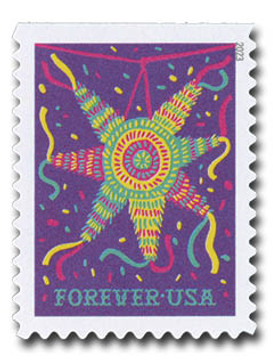
US #5815
2023 Donkey Piñata Facing Right – Piñatas
- Pictures a colorful donkey piñata representing a popular tradition in Mexican culture that has slowly spread to the United States and beyond
Stamp Category: Commemorative
Set: Piñatas
Value: 66¢ First Class Mail Rate (Forever)
First Day of Issue: September 8, 2023
First Day City: Roswell, New Mexico
Quantity Issued: 150,000,000
Printed by: Ashton Potter (USA) Ltd.
Printing Method: Offset
Format: Double-sided Booklets of 20
Tagging: Nonphosphored type III, block tagged
Why the stamp was issued: To commemorate the tradition of piñatas in Mexican culture.
About the stamp design: Pictures a colorful digital illustration of a traditional donkey piñata design on a vibrant orange background. Artwork by Victor Meléndez.
First Day City: The First Day of Issue Ceremony was held in Roswell, New Mexico during the 36th annual Piñata Festival.
About the Piñatas set: Includes four stamps picturing digital artwork of two traditional piñata designs – donkeys and seven-point stars. The stamps are not only a celebration of piñatas as a tradition, but also as a part of Mexican culture and its importance to many Americans.
History the stamp represents: While piñatas are most often associated with Mexico, similar traditions have been found around the world dating back centuries.
Many trace the history of piñatas to China. In the late 1200s, Italian explorer Marco Polo observed Chinese New Year celebrations. These celebrations included seed-filled containers shaped like livestock and covered in colorful paper. Celebrants gathered around the container and hit it with sticks. When it broke, they collected the broken pieces and burned them, saving the ashes for good fortune in the coming year.
Shortly after, the practice was introduced in Italy as “Piñata Sunday” during lent celebrations. The word piñata comes from the Italian word pignatta, which means “pot,” and likely comes from pigna, meaning “pine cone.” Before long, the tradition spread to Spain, where a party on the first Sunday of Lent was called the “Dance of the Piñata.” Celebrants used a clay pot decorated with paper, ribbon, and tinsel.
Spanish missionaries brought piñatas with them to North America in the 1300s and found the indigenous people had a similar tradition. The missionaries gave their piñatas more religious meaning in the hopes of converting the indigenous people to Christianity. Over time, these traditions, mixed with the existing local traditions, gave us the piñatas we have today.






